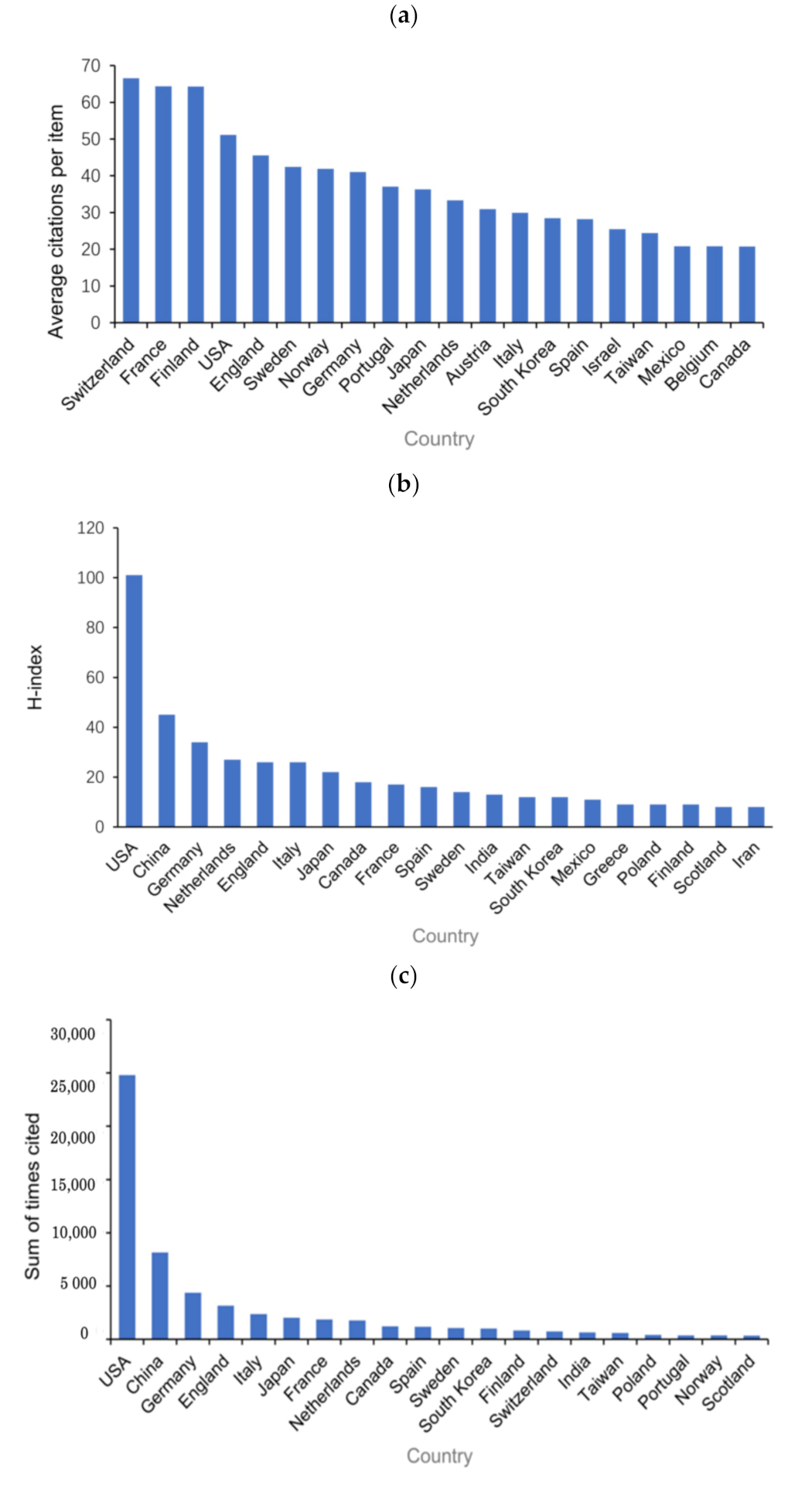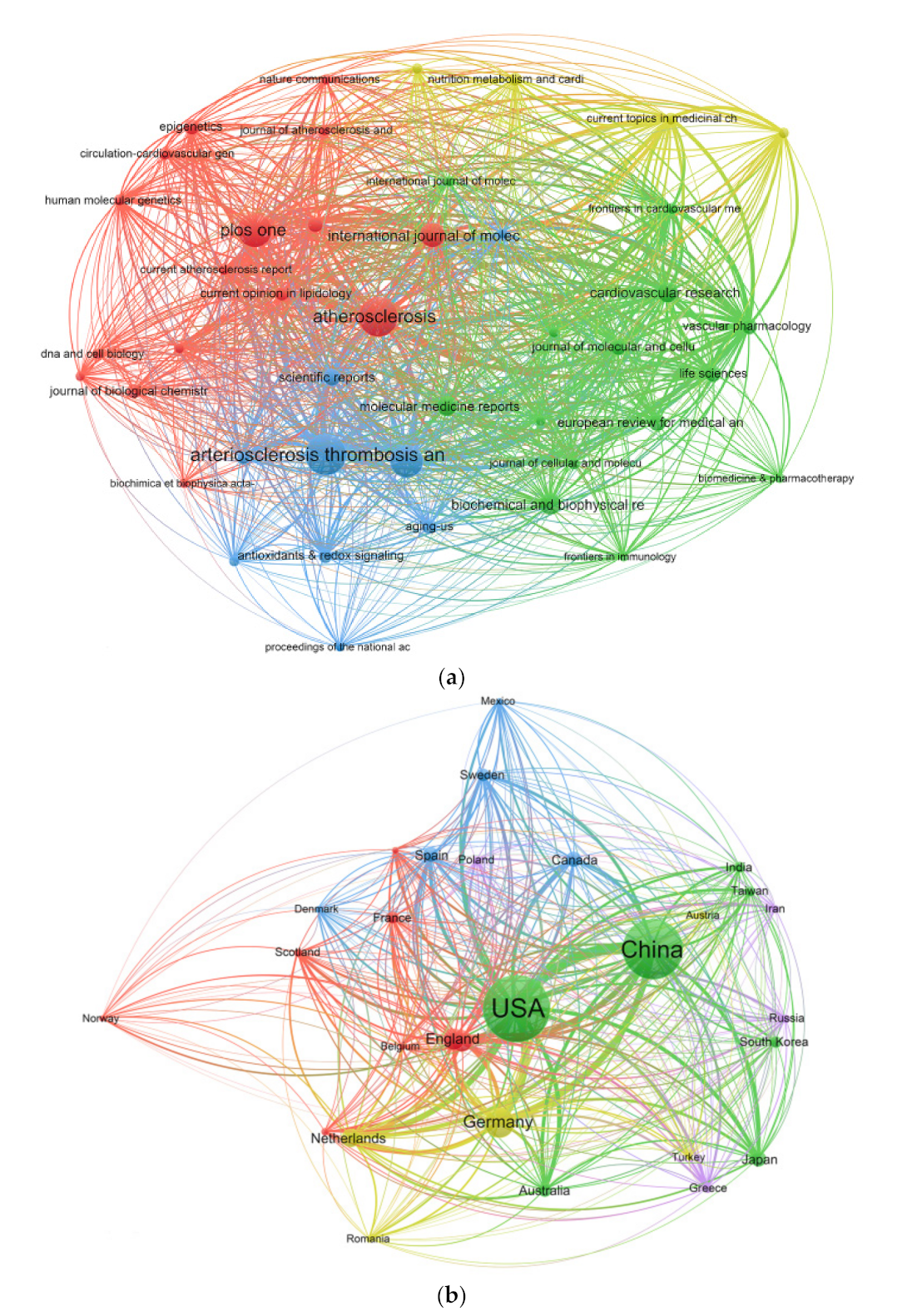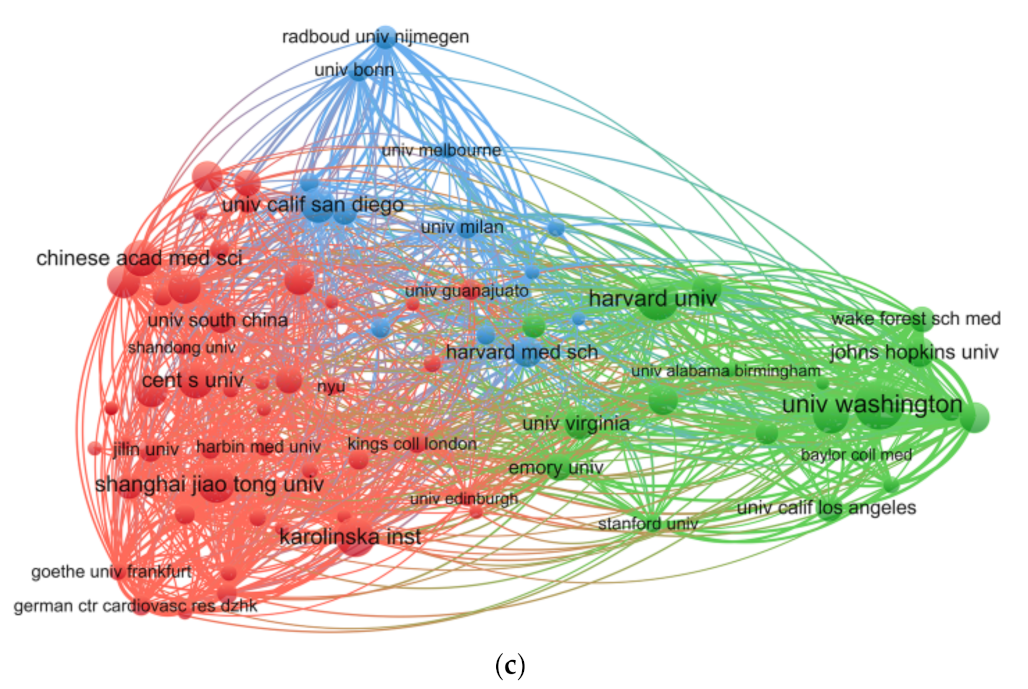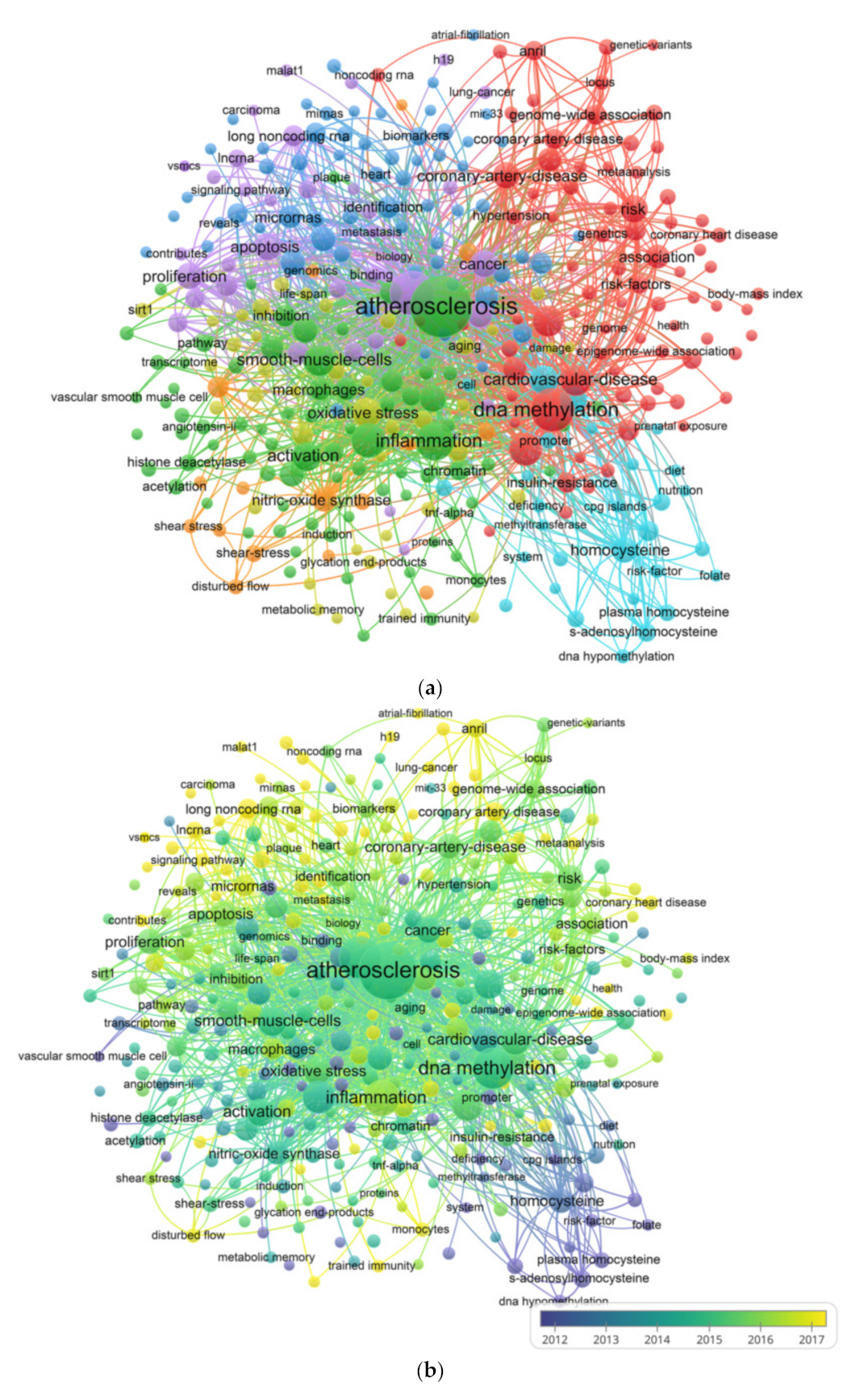Global Trends in Atherosclerosis Research in the Epigenetics Field: Bibliometric and Visualization Studies
Abstract
:1. Introduction
2. Materials and Methods
2.1. Data Sources
2.2. Search Strategy
2.3. Data Collection
2.4. Bibliometric Analysis
2.5. Visual Analysis
3. Results
3.1. Contributing to Atherosclerosis and Epigenetics
3.2. Citation Numbers
3.3. H-Index
3.4. Institutions and Publications
3.5. Bibliographic Coupling Analysis
3.6. Co-Occurrence Analysis
4. Discussion
5. Conclusions
Author Contributions
Funding
Institutional Review Board Statement
Informed Consent Statement
Data Availability Statement
Conflicts of Interest
References
- Hansson, G.K.; Hermansson, A. The immune system in atherosclerosis. Nat. Immunol. 2011, 12, 204–212. [Google Scholar] [CrossRef] [PubMed]
- Cavalli, G.; Heard, E. Advances in epigenetics link genetics to the environment and disease. Nature 2019, 571, 489–499. [Google Scholar] [CrossRef] [Green Version]
- Koelwyn, G.J.; Corr, E.M.; Erbay, E.; Moore, K.J. Regulation of macrophage immunometabolism in atherosclerosis. Nat. Immunol. 2018, 19, 526–537. [Google Scholar] [CrossRef] [Green Version]
- Kuznetsova, T.; Prange, K.H.M.; Glass, C.K.; de Winther, M.P.J. Transcriptional and epigenetic regulation of macrophages in atherosclerosis. Nat. Rev. Cardiol. 2020, 17, 216–228. [Google Scholar] [CrossRef]
- Karthika, C.L.; Ahalya, S.; Radhakrishnan, N.; Kartha, C.C.; Sumi, S. Hemodynamics mediated epigenetic regulators in the pathogenesis of vascular diseases. Mol. Cell Biochem. 2020, 476, 125–143. [Google Scholar] [CrossRef] [PubMed]
- Kwon, D.H.; Ryu, J.; Kim, Y.K.; Kook, H. Roles of Histone Acetylation Modifiers and Other Epigenetic Regulators in Vascular Calcification. Int. J. Mol. Sci. 2020, 21, 3246. [Google Scholar] [CrossRef]
- Napoli, C.; Benincasa, G.; Schiano, C.; Salvatore, M. Differential epigenetic factors in the prediction of cardiovascular risk in diabetic patients. Eur. Heart J. Cardiovasc. Pharmacother. 2020, 6, 239–247. [Google Scholar] [CrossRef] [PubMed] [Green Version]
- Mason, R.J.; Vondriska, T.M. Chromatin Is the Same in a Relative Way (But You’re Older). Circ. Res. 2019, 125, 209–211. [Google Scholar] [CrossRef] [PubMed]
- Scisciola, L.; Rizzo, M.R.; Cataldo, V.; Fontanella, R.A.; Balestrieri, M.L.; D’Onofrio, N.; Marfella, R.; Paolisso, G.; Barbieri, M. Incretin drugs effect on epigenetic machinery: New potential therapeutic implications in preventing vascular diabetic complications. FASEB J. 2020, 34, 16489–16503. [Google Scholar] [CrossRef] [PubMed]
- Toma, L.; Sanda, G.M.; Niculescu, L.S.; Deleanu, M.; Sima, A.V.; Stancu, C.S. Phenolic Compounds Exerting Lipid-Regulatory, Anti-Inflammatory and Epigenetic Effects as Complementary Treatments in Cardiovascular Diseases. Biomolecules 2020, 10, 641. [Google Scholar] [CrossRef] [PubMed] [Green Version]
- Gorabi, A.M.; Penson, P.E.; Banach, M.; Motallebnezhad, M.; Jamialahmadi, T.; Sahebkar, A. Epigenetic control of atherosclerosis via DNA methylation: A new therapeutic target? Life Sci. 2020, 253, 117682. [Google Scholar] [CrossRef]
- Liu, M.; Yan, M.; Lv, H.; Wang, B.; Lv, X.; Zhang, H.; Xiang, S.; Du, J.; Liu, T.; Tian, Y.; et al. Macrophage K63-Linked Ubiquitination of YAP Promotes Its Nuclear Localization and Exacerbates Atherosclerosis. Cell Rep. 2020, 32, 107990. [Google Scholar] [CrossRef]
- Pirillo, A.; Svecla, M.; Catapano, A.L.; Holleboom, A.G.; Norata, G.D. Impact of protein glycosylation on lipoprotein metabolism and atherosclerosis. Cardiovasc. Res. 2021, 117, 1033–1045. [Google Scholar] [CrossRef] [PubMed]
- Xu, S.; Pelisek, J.; Jin, Z.G. Atherosclerosis Is an Epigenetic Disease. Trends Endocrinol. Metab. 2018, 29, 739–742. [Google Scholar] [CrossRef]
- Gillette, T.G.; Hill, J.A. Readers, writers, and erasers: Chromatin as the whiteboard of heart disease. Circ. Res. 2015, 116, 1245–1253. [Google Scholar] [CrossRef] [PubMed] [Green Version]
- Xu, S.; Kamato, D.; Little, P.J.; Nakagawa, S.; Pelisek, J.; Jin, Z.G. Targeting epigenetics and non-coding RNAs in atherosclerosis: From mechanisms to therapeutics. Pharmacol. Ther. 2019, 196, 15–43. [Google Scholar] [CrossRef] [PubMed]
- Lu, Y.; Sun, Y.; Drummer, C.t.; Nanayakkara, G.K.; Shao, Y.; Saaoud, F.; Johnson, C.; Zhang, R.; Yu, D.; Li, X.; et al. Increased acetylation of H3K14 in the genomic regions that encode trained immunity enzymes in lysophosphatidylcholine-activated human aortic endothelial cells—Novel qualification markers for chronic disease risk factors and conditional DAMPs. Redox Biol. 2019, 24, 101221. [Google Scholar] [CrossRef]
- Jiang, X.; Liu, Z.; Qi, X. LncRNA BANCR induced vascular smooth muscle cell proliferation by downregulating miR-34c methylation in atherosclerosis. J. Thromb. Thrombolysis 2021, 51, 924–932. [Google Scholar] [CrossRef]
- Li, Y.; Xu, S.; Mihaylova, M.M.; Zheng, B.; Hou, X.; Jiang, B.; Park, O.; Luo, Z.; Lefai, E.; Shyy, J.Y.; et al. AMPK phosphorylates and inhibits SREBP activity to attenuate hepatic steatosis and atherosclerosis in diet-induced insulin-resistant mice. Cell Metab. 2011, 13, 376–388. [Google Scholar] [CrossRef] [PubMed] [Green Version]
- Zhang, Y.; Qian, H.; Wu, B.; You, S.; Wu, S.; Lu, S.; Wang, P.; Cao, L.; Zhang, N.; Sun, Y. E3 Ubiquitin ligase NEDD4 familyregulatory network in cardiovascular disease. Int. J. Biol. Sci. 2020, 16, 2727–2740. [Google Scholar] [CrossRef]
- Menni, C.; Gudelj, I.; Macdonald-Dunlop, E.; Mangino, M.; Zierer, J.; Besic, E.; Joshi, P.K.; Trbojevic-Akmacic, I.; Chowienczyk, P.J.; Spector, T.D.; et al. Glycosylation Profile of Immunoglobulin G Is Cross-Sectionally Associated with Cardiovascular Disease Risk Score and Subclinical Atherosclerosis in Two Independent Cohorts. Circ. Res. 2018, 122, 1555–1564. [Google Scholar] [CrossRef]
- Danthi, N.; Wu, C.O.; Shi, P.; Lauer, M. Percentile ranking and citation impact of a large cohort of National Heart, Lung, and Blood Institute-funded cardiovascular R01 grants. Circ. Res. 2014, 114, 600–606. [Google Scholar] [CrossRef] [PubMed] [Green Version]
- Shi, B.; Wei, W.; Qin, X.; Zhao, F.; Duan, Y.; Sun, W.; Li, D.; Cao, Y. Mapping theme trends and knowledge structure on adipose-derived stem cells: A bibliometric analysis from 2003 to 2017. Regen. Med. 2019, 14, 33–48. [Google Scholar] [CrossRef] [PubMed] [Green Version]
- Zhang, X.; Zhao, X.; Liu, K.; Che, Y.; Qiu, X.; Qu, Y.; Sun, X.; Song, J. Bufalin: A Systematic Review of Research Hotspots and Antitumor Mechanisms by Text Mining and Bioinformatics. Am. J. Chin. Med. 2020, 48, 1633–1650. [Google Scholar] [CrossRef]
- Wang, B.; Xing, D.; Zhu, Y.; Dong, S.; Zhao, B. The State of Exosomes Research: A Global Visualized Analysis. BioMed Res. Int. 2019, 2019, 1495130. [Google Scholar] [CrossRef] [PubMed] [Green Version]
- Shukla, N.; Merigó, J.M.; Lammers, T.; Miranda, L. Half a century of computer methods and programs in biomedicine: A bibliometric analysis from 1970 to 2017. Comput. Methods Programs Biomed. 2020, 183, 105075. [Google Scholar] [CrossRef]
- Polero, P.; Rebollo-Seco, C.; Adsuar, J.C.; Pérez-Gómez, J.; Rojo-Ramos, J.; Manzano-Redondo, F.; Garcia-Gordillo, M.; Carlos-Vivas, J. Physical Activity Recommendations during COVID-19: Narrative Review. Int. J. Environ. Res. Public Health 2020, 18, 65. [Google Scholar] [CrossRef] [PubMed]
- Manyangu, G.; Dineen, B.; Geoghegan, R.; Flaherty, G. Descriptive bibliometric analysis of global publications in lifestyle-based preventive cardiology. Eur. J. Prev. Cardiol. 2019, 228, 1303–1314. [Google Scholar] [CrossRef]
- Bertoli-Barsotti, L.; Lando, T. A theoretical model of the relationship between the h-index and other simple citation indicators. Scientometrics 2017, 111, 1415–1448. [Google Scholar] [CrossRef] [PubMed] [Green Version]
- Adnan, S.; Ullah, R. Top-cited Articles in Regenerative Endodontics: A Bibliometric Analysis. J. Endod. 2018, 44, 1650–1664. [Google Scholar] [CrossRef]
- Gao, J.; Xing, D.; Dong, S.; Lin, J. The primary total knee arthroplasty: A global analysis. J. Orthop. Surg. Res. 2020, 15, 190. [Google Scholar] [CrossRef] [PubMed]
- Mao, X.; Guo, L.; Fu, P.; Xiang, C. The status and trends of coronavirus research: A global bibliometric and visualized analysis. Medicine 2020, 99, e20137. [Google Scholar] [CrossRef] [PubMed]
- Yin, M.C.; Wang, H.S.; Yang, X.; Xu, C.Q.; Wang, T.; Yan, Y.J.; Fan, Z.X.; Ma, J.M.; Ye, J.; Mo, W. A Bibliometric Analysis and Visualization of Current Research Trends in Chinese Medicine for Osteosarcoma. Chin. J. Integr. Med. 2020, 1–8. [Google Scholar] [CrossRef] [PubMed]
- Xia, N.; Xie, Q.; Griffin, M.A.; Ye, G.; Yuan, J. Antecedents of safety behavior in construction: A literature review and an integrated conceptual framework. Accid. Anal. Prev. 2020, 148, 105834. [Google Scholar] [CrossRef] [PubMed]
- Bougioukas, K.I.; Vounzoulaki, E.; Mantsiou, C.D.; Savvides, E.D.; Karakosta, C.; Diakonidis, T.; Tsapas, A.; Haidich, A.B. Methods for depicting overlap in overviews of systematic reviews: An introduction to static tabular and graphical displays. J. Clin. Epidemiol. 2020, 132, 34–45. [Google Scholar] [CrossRef] [PubMed]





| Institution | No. (%) of Publications (N = 1848) |
|---|---|
| Washington University | 36 (1.95) |
| Harvard University | 33 (1.79) |
| Karolinska inst | 28 (1.52) |
| Shanghai jiaotong University | 28 (1.52) |
| Chinese Academy of Medical Sciences | 27 (1.46) |
| Rank | Journal | No. (%) of Publications (N = 1848) |
|---|---|---|
| 1 | Arteriosclerosis thrombosis and vascular biology | 66(3.57) |
| 2 | Atherosclerosis | 61(3.30) |
| 3 | Circulation research | 50(2.71) |
| 4 | Plos one | 49(2.65) |
| 5 | International journal of molecular | 33(1.79) |
Publisher’s Note: MDPI stays neutral with regard to jurisdictional claims in published maps and institutional affiliations. |
© 2021 by the authors. Licensee MDPI, Basel, Switzerland. This article is an open access article distributed under the terms and conditions of the Creative Commons Attribution (CC BY) license (https://creativecommons.org/licenses/by/4.0/).
Share and Cite
Jia, L.; Cheng, A.; Alam, N.; Qian, Y.; Ma, Z.; Ren, H.; Wang, R.; Liu, E. Global Trends in Atherosclerosis Research in the Epigenetics Field: Bibliometric and Visualization Studies. Int. J. Environ. Res. Public Health 2021, 18, 13154. https://doi.org/10.3390/ijerph182413154
Jia L, Cheng A, Alam N, Qian Y, Ma Z, Ren H, Wang R, Liu E. Global Trends in Atherosclerosis Research in the Epigenetics Field: Bibliometric and Visualization Studies. International Journal of Environmental Research and Public Health. 2021; 18(24):13154. https://doi.org/10.3390/ijerph182413154
Chicago/Turabian StyleJia, Linying, Ao Cheng, Naqash Alam, Yuxuan Qian, Zeyao Ma, Honghao Ren, Rong Wang, and Enqi Liu. 2021. "Global Trends in Atherosclerosis Research in the Epigenetics Field: Bibliometric and Visualization Studies" International Journal of Environmental Research and Public Health 18, no. 24: 13154. https://doi.org/10.3390/ijerph182413154
APA StyleJia, L., Cheng, A., Alam, N., Qian, Y., Ma, Z., Ren, H., Wang, R., & Liu, E. (2021). Global Trends in Atherosclerosis Research in the Epigenetics Field: Bibliometric and Visualization Studies. International Journal of Environmental Research and Public Health, 18(24), 13154. https://doi.org/10.3390/ijerph182413154





